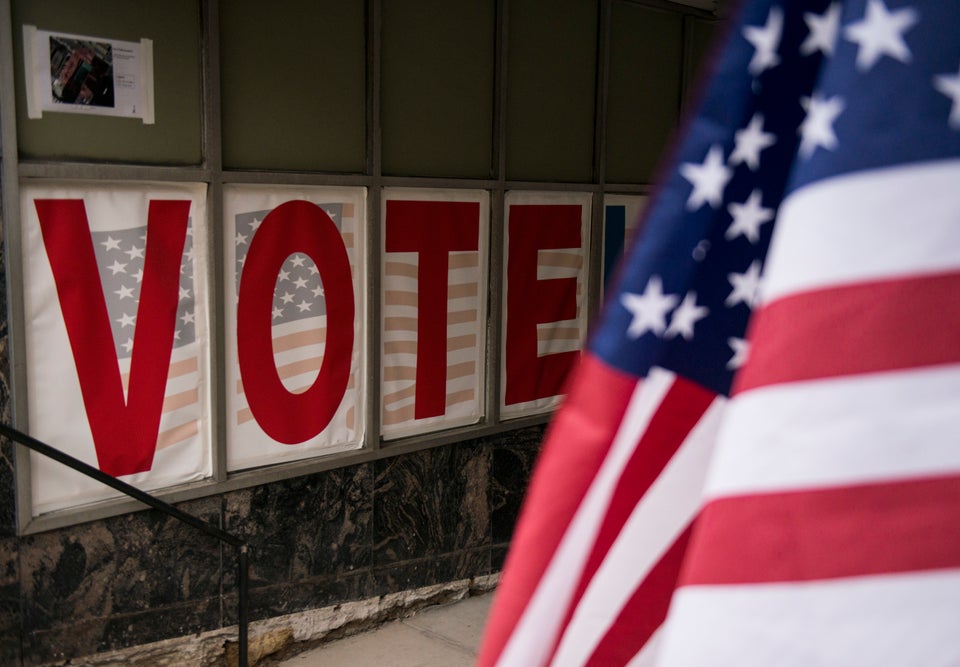
Voter turnout in the United States is abysmal, far worse than it is in most other developed countries.
In 2014, U.S. voter participation was the lowest it had been in more than 70 years — with less than half the population voting in 43 states. In general elections, for which voter turnout is typically highest, there are still some 88 million adults in the United States who are eligible to vote, but don’t.
Even among those who do vote, an alarming number of ballots don’t end up getting counted. In each of the presidential elections that took place between 1992 and 2004, according to a 2005 analysis in the University of Chicago’s Journal of Politics, more than 2 million votes were cast but never tallied — totaling nearly 9 million votes that went uncounted because they were blank, marked incorrectly, or otherwise spoiled.
“It’s a wicked problem,” says Whitney Quesenbery, a co-director at the Center for Civic Design. “We’ve always been in this battle between good, fast and easy — but still accurate, reliable, accessible and all those other good things voting needs to be.”
Most agree that a turning point came after disastrous issues with ballots in the 2000 election called into question the outcome of the matchup between George W. Bush and Al Gore.
Up until then, ballot design had “received scant attention from political scientists and political practitioners over the preceding century,” as the political scientists Charles Stewart and Stephen Ansolabehere wrote for the Journal of Politics. “The most dramatic manifestation occurred in Palm Beach County, Florida, where two major problems cast doubt over the integrity of the election. Poor ballot design confused a significant number of voters about how to cast a vote. And, poor vote tabulator design made it difficult to determine intentions of voters.”
The 2000 election was made infamous by the “hanging chads” and “pregnant chads” on ballot punch cards, a system that had been touted as technologically innovative and ultra-fast — until it failed. The chads, stray bits of paper from improperly punched-out votes, made it impossible for tabulators to determine how people had voted. Bush won the election. And ever since, government officials and voter advocates have been working to prevent the kind of confusion that plagued the contest that year.
More recently in Florida, election officials have focused on upgrades to the “Vote-by-Mail Ballot,” referred to previously as an absentee ballot, which any voter in the state can request. Across the country, more than one-third of overall voters are expected to vote by mail before election day. In Florida, because of the large population of part-time residents and seniors, about half of all votes are cast ahead of time.
“So that becomes a pretty large segment of our votes that are cast,” says David Stafford, the supervisor of elections in Escambia County, Florida, on the west side of the state. “In our county, about one-quarter of all ballots are done through the mail. In other counties, it’s much higher than that.”
Stafford and his colleagues have made several key changes to the design of mail-in ballots in recent years, including simplifying voting instructions and putting them in checklist form so voters don’t forget essential actions like signing their names. (Forgetting one’s signature is one of the major reasons for spoiled ballots.) Ballots in Escambia County now also feature larger text and a bright red box to draw attention to the signature area. “On the lower-left corner of the envelope, there’s yet another red swoosh that says, ‘Remember: sign and date the back,’” Stafford told me. “We looked at everything from the outgoing envelope to the incoming envelope to the secrecy sleeve—and basically redesigned everything.”

Stafford calls the changes “fairly simple stuff,” but they’ve already made a real difference. Though the total number of spoiled ballots in his county was low to begin with — under 1 percent — the error rate dropped by 42 percent once the new designs were implemented. “It was enough that we felt like it made a difference,” Stafford said.
Implementing ballot-design changes, no matter how seemingly straightforward, is complicated. “Often ballot change requires legislation, and that’s part of what makes it so slow,” says Quesenbery, of the Center for Civic Design, “even when you have elected officials who understand that we are hurting voters when we don’t fix things.”
““Often ballot change requires legislation, and that’s part of what makes it so slow even when you have elected officials who understand that we are hurting voters when we don’t fix things.””
RELATED: Abolish the Secret Ballot
So although best practices say that ballots shouldn’t be printed in all caps, for instance, a local law might dictate the opposite. That’s the case in Arapahoe County, Colorado, says Jennifer Morrell, the county’s deputy of elections and records. Colorado is one of three states, along with Oregon and Washington, that automatically mails paper ballots to every registered voter, without a voter having to request a ballot ahead of time. Such measures may be good for voter turnout, but they’re also a strain on government coffers — and costs can make design changes even harder to pull off.
Morrell recalls being faced with the decision of whether to keep a ballot to one page, or to add a second page. “Do we have one really long ballot with a really tiny font, and save the cost of a second page? Or do we bump the cost up and go to a second-page ballot? Now, that doesn’t sound like a big deal, but we have nearly 400,000 voters — so it ends up being [an additional] $90,000 just for printing. Not counting postage!” (Ultimately, she and her colleagues opted for a second page with larger lettering, she says.)
Morrell also worked to simplify voting instructions in her county, winnowing them down to a three-point list that includes an illustration depicting the proper way to fill out a ballot.

In some instances, lawmakers are less than enthusiastic about overhauling the design of a ballot — because the design in question is the one that got them elected in the first place. Even elections officials, who are ostensibly tasked with making ballots as voter-friendly as possible, can stand in the way of improvements. “Elections officials don’t like hearing that their ballots are no good,” Quesenbery told me.
Complicating matters further is the fact that, to paraphrase Leo Tolstoy, every terrible ballot is terrible in its own way. “There are 9,000 election systems in our country — state, county, local entities,” says Jim Duffet, the national coalition director of the National Election Defense Coalition. That’s part of why a new bill, introduced by Georgia Representative Hank Johnson, a Democrat, would establish some federal standards to apply nationwide — like requiring “durable and readable paper ballots,” according to Johnson’s website.
The consensus among elections officials and voter advocates is that paper ballots remain essential in 2016. Some jurisdictions use paper for in-person votes as well as absentee ballots, and many electronic voting machines print out a paper receipt. Electronic voting carries its own set of design challenges, though, on top of the question of what happens to the voting record if a system fails or is hacked. That’s in part because so many electronic systems are already outdated. In this year’s general election, 42 states will use machines that are more than a decade old, says Lawrence Norden, the deputy director of the Brennan Center’s Democracy Program. In other words, people are voting on systems that have been around since everybody was using flip phones. Now, in the age of the smartphone, voters often try to swipe from one screen to the next, and have difficulty with “next” or “back” buttons on old machines.
“In this year’s general election, 42 states will use machines that are more than a decade old.”
“Hopefully as we start replacing these machines we’ll have better ballots, but the federal certification standards for these machines haven’t caught up to where we should be,” Norden said. “Some vendors have voluntarily [made upgrades], but they’re still not as good as they should be — and really we should have certification standards that require more flexibility.”
That said, one benefit to an electronic system is that once software is upgraded, it’s upgraded for everyone who uses it — across any number of jurisdictions. Which means improvements to electronic systems may be implemented more quickly than improvements to paper.
Making a better ballot, several elections officials told me, also requires considering textual meaning — not just text placement — as an element of design. “Plain language is pretty important, even if you design the ballot well otherwise,” says Noah Praetz, the director of elections in Cook County, Illinois. Consider, for example, the language of this referendum, which will appear on ballots in Illinois in November:
Shall the extension limitation under the Property Tax Extension Limitation Law for Norridge School District Number 80, Cook County, Illinois, be increased from the lesser of 5% or the percentage increase in the Consumer Price Index over the prior levy year to 73.6% for the 2016 levy year? For the 2016 levy year the approximate amount of the additional tax extendable against property containing a single family residence and having a fair market value at the time of the referendum of $100,000 is estimated to be $479.
“What the hell does that mean?” Praetz said. “It’s very difficult to put that before a voter if they’re not a tax accountant, and get them to understand.”
“So there are still challenges,” he added.
In many jurisdictions, ballots have improved dramatically in the past decade and a half, but it’s difficult — maybe even impossible — to assess how ballots are changing on larger scale because each place is “hugely different,” says Norden, from the Brennan Center. “There’s a different process in each of those election jurisdictions. On top of that, you have different voting machines that allow for different ability to do things. And then, you have very different laws.”
The result is that even as some ballots and voting systems improve, many others will stay the same—or, potentially, get worse. “The bad news is that the future is unevenly applied, as always,” Quesenbery told me. “But I think there’s some good news... Things change slowly, but once they begin to change—they can change quickly.”
This story originally appeared on TheAtlantic.com.
More from The Atlantic: How to Email, No, Not Gary Johnson

